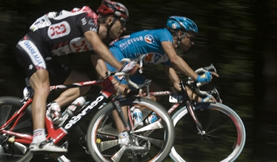
LET'S START RACING!
| home |
| governing orgs |
| missouri clubs |
| general info |
| race prep |
MEMEBERS ONLY AREA: access to roster and contact info (password=letmein)
Things You Need to Know 7 Points of Race Preparation (thank you Big Shark!) Get You Bike In Shape: For safe and efficient racing, your bicycle must be in excellent working order. It should shift and brake perfectly. The tires should be new or nearly new. And, all the parts should be tight, properly adjusted and lubricated. Get Yourself In Shape: Now that your bike's dialed, it’s time to tune up the motor. If you’ve been sitting on the couch all winter watching ER reruns, chances are you’re not ready to race. Put down the potato chips and get on the bike! Get at least four weeks of riding in your legs before entering your first race. You don't need to ride every day. But you want some miles in your legs in order to make your first race experience a pleasurable one. If you’re racing in the Beginner Class race, chances are it won’t last more than two hours. Make sure the majority of your rides are at least this long so you’ll feel confident about finishing. Find The Races: You can usually find information in the newspapers' local sports listings, too. Look for event listings in cycling magazines such as VeloNews, which has an events calendar organized by location to make it easy to find events not too far away. Another way to find out about races is to ask the people you ride with. If they've been racing for a while, they'll have a feel for which races are the most fun and will know when they're coming up. Buy a Racing License and Pre-Register: Most races are governed by organizations such as NORBA (National Off-Road Bicycling Association) and USA Cycling. To enter these races you're required to purchase a racing license. Depending on the event, you might be able to buy a one-day license. However, if you plan to race regularly, you should probably purchase a regular license, which will cost more, but will permit you to race all year long. Practice Group Riding: If you haven't ridden in a group, you should practice before entering a race because pedaling in close proximity can be unnerving. In fact, it's not unusual in races to get bumped into. If you're used to it, it won't bother you. If you're not, you might crash or cause one. The best way to learn is to join a friendly group ride. Be sure to find the group leader before the ride starts and tell him that you're there to learn. Learn to Fix a Flat Tire: Every cyclist should know how to repair a flat tire because it's the most likely breakdown. Flat half way into a 60-mile road race, and you're in for a long haul home if you can't repair the tire. Also, one of the unique rules of mountain bike racing is that competitors can't accept outside mechanical support. This means that if you get a flat, you'll have to fix it on your own or risk disqualification. Pre-Ride the Course: Once you've prepared yourself and your bike to race and you've picked a race or two to enter, it's best to pre-ride the course. Usually, you should do this a couple days before the event when there's no pressure and when others aren't racing on the course (as is the case on race day). Pre-riding also gives you a chance to gauge the fitness and skill you’ll need to finish the race.
|
| FEATURED LINKS! | ||
|
||

